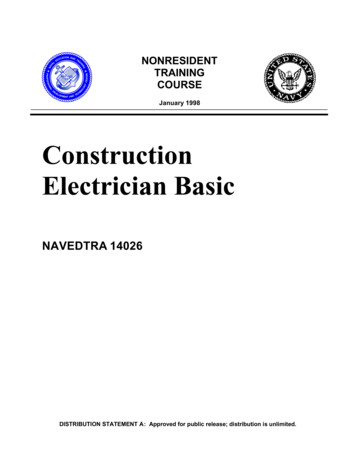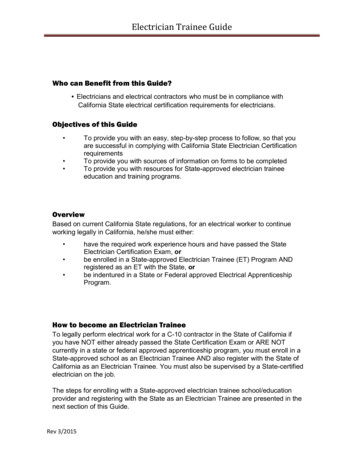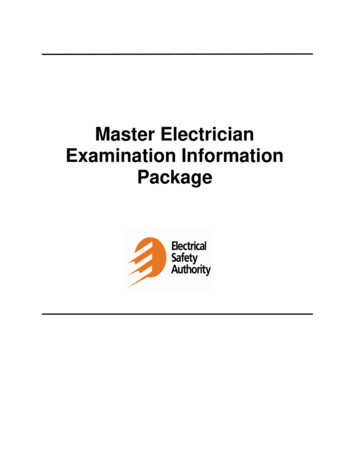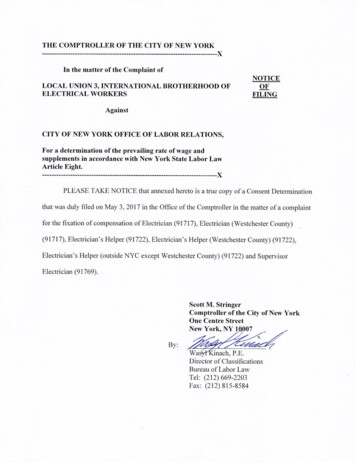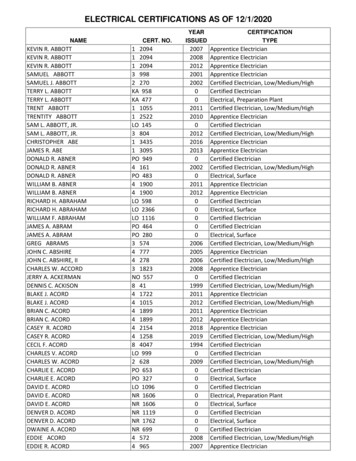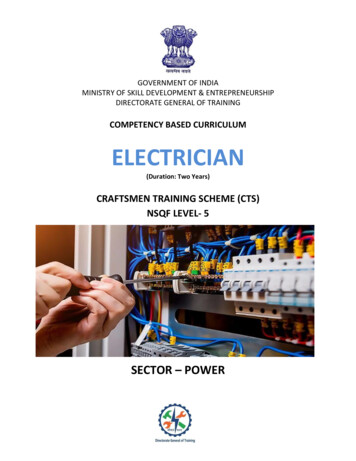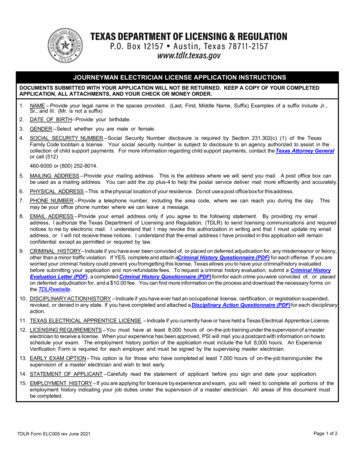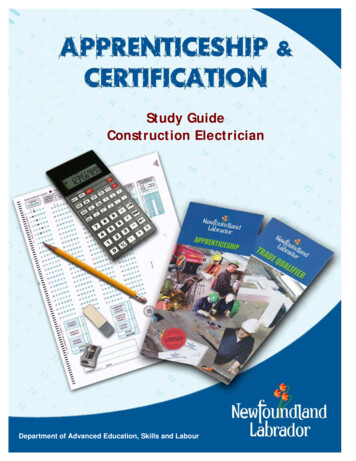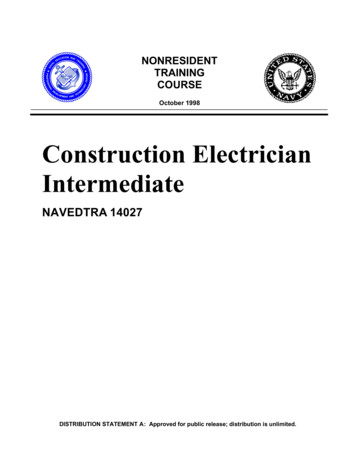
Transcription
NONRESIDENTTRAININGCOURSEOctober 1998Construction ElectricianIntermediateNAVEDTRA 14027DISTRIBUTION STATEMENT A: Approved for public release; distribution is unlimited.
Although the words “he,” “him,” and“his” are used sparingly in this course toenhance communication, they are notintended to be gender driven or to affront ordiscriminate against anyone.DISTRIBUTION STATEMENT A: Approved for public release; distribution is unlimited.
COMMANDING OFFICERNETPDTC6490 SAUFLEY FIELD RDPENSACOLA, FL 32509-5237ERRATA13 Jun 2001Specific Instructions and Errata forNonresident Training CourseCONSTRUCTION ELECTRICIAN INTERMEDIATE,NAVEDTRA 140271. No attempt has been made to issue corrections for errors in typing,punctuation, etc., that do not affect your ability to answer the question orquestions.2.Make the following changes:a. Page 5-12, figure 5-10, add the following sentence to the figurecaption: “Lamp is lit when voltage is present.”b. Page 5-12, figure 5-11, delete the existing figure caption and replacethe caption with “Second step in testing an outlet with a neon tester.Lamp is lit only when voltage is present.”c. Page 5–13, figure 5-12. Note these changes to the figure: The terminalsin figure 5-12 should be the same as in figure 5-13 (power input on thebottom terminal and load on the top terminal). Consequently, the neontester lead should be on the top terminal and the tester lamp should beOFF to indicate the condition set in the figure caption.d. Page 5-14, figure 5-17, add the following sentence to the figurecaption. “Lamp should glow only when test lead is in the right sideoutlet slot and voltage is present.”e. Page 5-15, under the title Fuse, change step 1 to read as follows:“1. First determine if voltage is present at the supply side of the fuseby placing one of the neon tester leads on the top of one fuse and theother lead to ground. Test the other fuse in the same manner. Glowinglamp indicates that voltage is supplied to the fuse.”f. Page 5-15, under the title Fuse, change step 2 to read as follows:“2. Determine if voltage is present at the load side of the fuse byplacing one lead of the neon tester on the bottom side of the fuse andthe other lead to ground. Test the other fuse in the same manner. If thetester lamp DOES NOT glow and voltage is present at the supply side ofthe fuse, the fuse is defective.”g. Page 5-16, delete figure 5-19 (all four views).h. Page 5-22, delete figure 5-28 and delete the first five lines of text inthe left column that apply to figure 5-28.i. Delete topic on “Airfield Lighting” from page 6-28 through page 6-50.This section on airfield lighting is deleted because airfield lightingis no longer covered by occupational standards for ConstructionElectricians.
j. Delete chapter 8 on “Alarm Systems.” This chapter is deleted becausefire alarms are no longer covered by occupational standards forConstruction Electricians.3. Delete the following questions, and leave the corresponding spaces blank onthe answer sheet:Questions5-11 through 5-275-64 through 5-75
PREFACEBy enrolling in this self-study course, you have demonstrated a desire to improve yourself and the Navy.Remember, however, this self-study course is only one part of the total Navy training program. Practicalexperience, schools, selected reading, and your desire to succeed are also necessary to successfully roundout a fully meaningful training program.THE COURSE: This self-study course is organized into subject matter areas, each containing learningobjectives to help you determine what you should learn along with text and illustrations to help youunderstand the information. The subject matter reflects day-to-day requirements and experiences ofpersonnel in the rating or skill area. It also reflects guidance provided by Enlisted Community Managers(ECMs) and other senior personnel, technical references, instructions, etc., and either the occupational ornaval standards, which are listed in the Manual of Navy Enlisted Manpower Personnel Classificationsand Occupational Standards, NAVPERS 18068.THE QUESTIONS: The questions that appear in this course are designed to help you understand thematerial in the text.VALUE: In completing this course, you will improve your military and professional knowledge.Importantly, it can also help you study for the Navy-wide advancement in rate examination. If you arestudying and discover a reference in the text to another publication for further information, look it up.1998 Edition Prepared byCECS Jose V. P. FerriolsPublished byNAVAL EDUCATION AND TRAININGPROFESSIONAL DEVELOPMENTAND TECHNOLOGY CENTERNAVSUP Logistics Tracking Number0504-LP-026-7050i
Sailor’s Creed“I am a United States Sailor.I will support and defend theConstitution of the United States ofAmerica and I will obey the ordersof those appointed over me.I represent the fighting spirit of theNavy and those who have gonebefore me to defend freedom anddemocracy around the world.I proudly serve my country’s Navycombat team with honor, courageand commitment.I am committed to excellence andthe fair treatment of all.”ii
CONTENTSPAGECHAPTER1. Construction Support . . . . . . . . . . . . . . . . . . . . . . . . 1-12. Drawings and Specifications. . . . . . . . . . . . . . . . . . . . . 2-13. Generators . . . . . . . . . . . . . . . . . . . . . . . . . . . . . . 3-14. Electrical Distribution . . . . . . . . . . . . . . . . . . . . . . . 4-15. Interior Wiring . . . . . . . . . . . . . . . . . . . . . . . . . . . . 5-16. Fiber Optics and Lighting Systems. . . . . . . . . . . . . . . . . . 6-17. Electrical Equipment . . . . . . . . . . . . . . . . . . . . . . . . . 7-18. Alarm Systems . . . . . . . . . . . . . . . . . . . . . . . . . . . . 8-1APPENDIXI.References Used to Develop the TRAMAN . . . . . . . . . . . . . AI-1INDEX . . . . . . . . . . . . . . . . . . . . . . . . . . . . . . . . . . . INDEX-lNonresident Training Course Follows The Indexiii
SUMMARY OF THECONSTRUCTION ELECTRICIANTRAINING SERIESCONSTRUCTION ELECTRICIAN BASICConstruction Electrician Basic, NAVEDTRA 11038, replaces ConstructionElectrician 3 and should be studied by those seeking advancement to ConstructionElectrician Third Class. The major topics in the Basic TRAMAN are constructionsupport activities, drawings and specifications, power generation and distribution,interior wiring, lighting and communication, and electrical appliances, testequipment, motors, and generators.CONSTRUCTION ELECTRICIAN INTERMEDIATEThis TRAMAN, replaces Construction Electrician 3&2 and should be studiedby those seeking advancement to Construction Electrician Second Class. Topics inthis book will be a continuation of information covered in the ConstructionElectrician Basic TRAMAN. The major topics in this TRAMAN are constructionsupport, drawings and specifications, generators, electrical distribution, interiorwiring, fiber optics and lighting systems, electrical equipment, and alarm sytems.CONSTRUCTION ELECTRICIAN ADVANCEDThis TRAMAN, when published (refer to NAVEDTRA 12061 for availability),will replace Construction Electrician 1 and should be studied by those seekingadvancement to Construction Electrician First Class. Topics in this book will be acontinuation of information covered in the Construction Electrician IntermediateTRAMAN.iv
SAFETY PRECAUTIONSSafety is a paramount concern for all personnel. Many of the Naval Ship’sTechnical Manuals, manufacturer’s technical manuals, and every PlannedMaintenance System (PMS) maintenance requirement card (MRC) include safetyprecautions. Additionally, OPNAVINST 5100.19 (series), Naval OccupationalSafety and Health (NAVOSH) Program Manual for Forces Afloat, andOPNAVINST 5100.23 (series), NAVOSH Program Manual, provide safety andoccupational health information. The safety precautions are for your protection andto protect equipment.During equipment operation and preventive or corrective maintenance, theprocedures may call for personal protective equipment (PPE), such as goggles,gloves, safety shoes, hard hats, hearing protection, and respirators. When specified,your use of PPE is mandatory. You must select PPE appropriate for the job since theequipment is manufactured and approved for different levels of protection. If theprocedure does not specify the PPE, and you aren’t sure, ask your safety officer.Most machinery, spaces, and tools requiring you to wear hearing protection areposted with hazardous noise signs or labels. Eye hazardous areas requiring you towear goggles or safety glasses are also posted. In areas where corrosive chemicalsare mixed or used, an emergency eyewash station must be installed.All lubricating agents, oil, cleaning material, and chemicals used inmaintenance and repair are hazardous materials. Examples of hazardous materialsare gasoline, coal distillates, and asphalt. Gasoline contains a small amount of leadand other toxic compounds. Ingestion of gasoline can cause lead poisoning. Coaldistillates, such as benzene or naphthalene in benzol, are suspected carcinogens.Avoid all skin contact and do not inhale the vapors and gases from these distillates.Asphalt contains components suspected of causing cancer. Anyone handlingasphalt must be trained to handle it in a safe manner.Hazardous materials require careful handling, storage, and disposal. PMSdocumentation provides hazard warnings or refers the maintenance man to theHazardous Materials User’s Guide. Material Safety Data Sheets (MSDS) alsoprovide safety precautions for hazardous materials. All commands are required tohave an MSDS for each hazardous material they have in their inventory. You mustbe familiar with the dangers associated with the hazardous materials you use in yourwork. Additional information is available from you command’s HazardousMaterial Coordinator. OPNAVINST 4110.2 (series), Hazardous Material Controland Management, contains detailed information on the hazardous materialprogram.Recent legislation and updated Navy directives implemented tighter constraintson environmental pollution and hazardous waste disposal. OPNAVINST 5090.1(series), Environmental and Natural Resources Program Manual, provides detailedinformation. Your command must comply with federal, state, and localenvironmental regulations during any type of construction and demolition. Yoursupervisor will provide training on environmental compliance.Cautions and warnings of potentially hazardous situations or conditions arehighlighted, where needed, in each chapter of this TRAMAN. Remember to besafety conscious at all times.v
INSTRUCTIONS FOR TAKING THE COURSEASSIGNMENTSassignments. To submit youranswers via the Internet, go to:The text pages that you are to study are listed atthe beginning of each assignment. Study thesepages carefully before attempting to answer thequestions. Pay close attention to tables andillustrations and read the learning objectives.The learning objectives state what you should beable to do after studying the material. Answeringthe questions correctly helps you accomplish theobjectives.http://courses.cnet.navy.milGrading by Mail: When you submit answersheets by mail, send all of your assignments atone time. Do NOT submit individual answersheets for grading. Mail all of your assignmentsin an envelope, which you either provideyourself or obtain from your nearest EducationalServices Officer (ESO). Submit answer sheetsto:SELECTING YOUR ANSWERSCOMMANDING OFFICERNETPDTC N3316490 SAUFLEY FIELD ROADPENSACOLA FL 32559-5000Read each question carefully, then select theBEST answer. You may refer freely to the text.The answers must be the result of your ownwork and decisions. You are prohibited fromreferring to or copying the answers of others andfrom giving answers to anyone else taking thecourse.Answer Sheets: All courses include one“scannable” answer sheet for each assignment.These answer sheets are preprinted with yourSSN, name, assignment number, and coursenumber. Explanations for completing the answersheets are on the answer sheet.SUBMITTING YOUR ASSIGNMENTSTo have your assignments graded, you must beenrolled in the course with the NonresidentTraining Course Administration Branch at theNaval Education and Training ). Following enrollment, there aretwo ways of having your assignments graded:(1) use the Internet to submit your assignmentsas you complete them, or (2) send all theassignments at one time by mail to NETPDTC.Grading on the Internet:Internet grading are: assignmentDo not use answer sheet reproductions: Useonly the original answer sheets that weprovide—reproductions will not work with ourscanning equipment and cannot be processed.Follow the instructions for marking youranswers on the answer sheet. Be sure that blocks1, 2, and 3 are filled in correctly. Thisinformation is necessary for your course to beproperly processed and for you to receive creditfor your work.Advantages toCOMPLETION TIMEyou may submit your answers as soon asyou complete an assignment, andyou get your results faster; usually by thenext working day (approximately 24 hours).Courses must be completed within 12 monthsfrom the date of enrollment. This includes timerequired to resubmit failed assignments.In addition to receiving grade results for eachassignment, you will receive course completionconfirmation once you have completed all thevi
PASS/FAIL ASSIGNMENT PROCEDURESFor subject matter questions:If your overall course score is 3.2 or higher, youwill pass the course and will not be required toresubmit assignments. Once your assignmentshave been graded you will receive coursecompletion milComm: (850) 452-1001, Ext. 1826DSN: 922-1001, Ext. 1826FAX: (850) 452-1370(Do not fax answer sheets.)Address: COMMANDING OFFICERNETPDTC (CODE 314)6490 SAUFLEY FIELD ROADPENSACOLA FL 32509-5237If you receive less than a 3.2 on any assignmentand your overall course score is below 3.2, youwill be given the opportunity to resubmit failedassignments. You may resubmit failedassignments only once. Internet students willreceive notification when they have failed anassignment--they may then resubmit failedassignments on the web site. Internet studentsmay view and print results for failedassignments from the web site. Students whosubmit by mail will receive a failing result letterand a new answer sheet for resubmission of eachfailed assignment.For enrollment, shipping,completion letter .navy.milToll Free: 877-264-8583Comm: (850) 452-1511/1181/1859DSN: 922-1511/1181/1859FAX: (850) 452-1370(Do not fax answer sheets.)Address: COMMANDING OFFICERNETPDTC (CODE N331)6490 SAUFLEY FIELD ROADPENSACOLA FL 32559-5000COMPLETION CONFIRMATIONAfter successfully completing this course, youwill receive a letter of completion.NAVAL RESERVE RETIREMENT CREDITERRATAhttp://www.advancement.cnet.navy.milIf you are a member of the Naval Reserve, youwill receive retirement points if you areauthorized to receive them under currentdirectives governing retirement of NavalReserve personnel. For Naval Reserveretirement, this course is evaluated at 8 points.(Refer to Administrative Procedures for NavalReservists on Inactive Duty, BUPERSINST1001.39, for more information about retirementpoints.)STUDENT FEEDBACK QUESTIONSCOURSE OBJECTIVESWe value your suggestions, questions, andcriticisms on our courses. If you would like tocommunicate with us regarding this course, weencourage you, if possible, to use e-mail. If youwrite or fax, please use a copy of the StudentComment form that follows this page.In completing this nonresident training course,you will demonstrate a knowledge of the subjectmatter by correctly answering questions on thefollowing subjects: Construction Support,Drawings and Specifications, Generators,Electrical Distribution, Interior Wiring, FiberOptics and Lighting, Electrical Equipment, andAlarm Systems.Errata are used to correct minor errors or deleteobsolete information in a course. Errata mayalso be used to provide instructions to thestudent. If a course has an errata, it will beincluded as the first page(s) after the front cover.Errata for all courses can be accessed andviewed/downloaded at:vii
Student CommentsCourse Title:Construction Electrician IntermediateNAVEDTRA:14027Date:We need some information about you:Rate/Rank and Name:SSN:Command/UnitStreet Address:City:State/FPO:ZipYour comments, suggestions, etc.:Privacy Act Statement: Under authority of Title 5, USC 301, information regarding your military status isrequested in processing your comments and in preparing a reply. This information will not be divulged withoutwritten authorization to anyone other than those within DOD for official use in determining performance.NETPDTC 1550/41 (Rev 4-00)ix
CHAPTER 1CONSTRUCTION SUPPORTINTRODUCTION(ABIOL), OPNAV 41P3, is a detailed itemized lineitem printout of the material in each ABFC. Eachsystem command (SYSCOM)/bureau is responsiblefor maintaining a detailed list of that portion of theABIOL of an ABFC for which it has been assignedcontributory responsibility.As a second class petty officer your duties andresponsibilities will increase in the area of construction support. This chapter will discuss some ofthese responsibilities, such as the Advanced BaseFunctional Components System, shoring andexcavation safety, project planning, network analysis,timekeeping, quality control, and hazardous materials.NAVFAC P-437The Facilities Planning Guide, NAVFAC P-437,is the basic document that identifies the structures andsupporting utilities of the ABFC System. It consists oftwo volumes.ADVANCED BASE FUNCTIONALCOMPONENTS (ABFC)The Advanced Base Functional Components(ABFC) System consists of two general-purposepublications: Table of Advanced Base FunctionalComponents with Abridged Initial Outfitting Lists,OPNAV-41P3, and Facilities Planning Guide, Volumes I and II, NAVFAC P-437.Volume I contains reproducible engineeringdrawings organized in three parts—Part I, ComponentSite Plans, indexed by component designation; Part II,Facility Drawings and Networks, indexed by facilitynumber; and Part III, Assembly Drawings, indexed byassembly numbers.The ABFC System was developed to providesupport facilities to constantly changing tactical andstrategic situations. A modular or building-blockconcept was developed. Components were needed thatwould incorporate men, materials, equipment, andfacilities designed and developed to fulfill specificfunctions, no matter where the components wereplaced. The Navy ABFC System is based on the earlyexperience in advanced base planning and shipmentused in World War II with improvements broughtabout by experiences learned in Korea, Vietnam, andthe Persian Gulf.Volume II contains the detailed data display foreach component, facility, and assembly in the ABFCSystem. It also has three parts. Part I quantifies anddescribes, by DoD category code, the facilitiesrequirements for each component. Part II quantifiesand describes, by assembly number, the assemblyrequirements for each facility. Part III quantifies lineitem requirements, by national stock number (NSN),for each assembly.Other information used for planning, such as thecrew size, man-hours by skill, land area, and fuelnecessary to make a component, facility, or assemblyoperational is contained in the guide.The Navy ABFC System is the quantitativeexpression and measurement of planning,procurement, assembly, and shipping of material andpersonnel that is needed to satisfy facility supportrequirements. The basic groupings of the ABFCSystem are (1) component, a complete unit; (2)facility, a portion of a complete component; and (3)assembly, a portion of a facility. These simpledefinitions and the interaction of these three units willbe fully explained later in this chapter.The NAVFAC P-437 includes facilities andassemblies that are not directly related to componentsshown in the OPNAV P-41P3. These predesignedfacilities and assemblies give the planner alternativesfor satisfying contingency requirements when thecallout of a complete component is not desired. For thepurpose of compatibility with other DOD planningsystems, the NAVFAC P-437 has been oriented to thestandard DOD category codes for classifying realproperty of the Navy, as listed in Department of theNavy Facility Codes, NAVFAC P-72. The cardinalcategory codes are shown in table 1-1.OPNAV 41P3The Table of Advanced Base FunctionalComponents with Abridged Initial Outfitting Lists1-1
Table 1-1.—Codes and Categories for Real PropertyCODES100200300400500600700800900USING THE P-437When you are using the ABFC System, rememberthat it is possible to tailor it to serve your specificneeds. Understand your exact requirements and mission. Choose components, facilities, or assemblies thatfit or can be tailored to meet your desired goals. Verifystock numbers and descriptions by using appropriatestock lists. Verification is done automatically whencomponents, facilities, or assemblies are ordered.CATEGORIESOperations and TrainingMaintenance and ProductionResearch. Development, and EvaluationSupplyHospital and MedicalAdministrativeHousing and Community SupportUtilities and Ground ImprovementsReal EstateA sample from volume II of NAVFAC P-437shows the structure and type of information provided.Figure 1-1 shows the P-25 component, Naval MobileConstruction Battalion. The component containsa listing of facilities by category code.A facility required for an electrical power plantwill be found in the 800 series, Utilities and GroundImprovements. The assemblies contained within eachof these facilities consist of a grouping of line items atthe national stock number level that, when assembled,will perform a specific function in support of thefacility. These assemblies are functionally grouped insuch a way that the assembly relates to the Seabee skillrequired to install it. These groupings are shown intable 1-2.One such facility is the electric power plant diesel,2-200 kW without tank, facility, 811 10R. Figure 1-2shows this facility. Note that within the facility thenecessary assemblies are identified.Figure 1-3 shows an assembly from within facility811 10R. The listing for assembly 32602, titled"PANELBOARD ASSY 1200A WEATHER-Table 1-2.—Assemblies Functionally Grouped to Seabee SkillsNUMBERSTARTDESCRIPTIONBuilder (BU) OrientedUtilitiesman (UT) OrientedConstruction Electrician (CE) OrientedSteelworker (SW) OrientedEquipment Operator (EO) OrientedWaterfront EquipmentUnderwater Construction and Diving EquipmentOperational SuppliesNBC WarfarePersonnel-Related SuppliesUnassigned at PresentShop Equipment including Maintenance ToolsUnique ABFC Tool KitsNCF TOA Construction Tools and Kits (Power Tools)NCF TOA Construction Tools and Kits (Electric)NCF TOA Construction Tools and Kits (Miscellaneous)NCF TOA Construction Tools and Kits (Rigging)Shop Equipment (ABFC 9981,99982,49982,99983,99984,99987,499
Figure 1-1.—Mobilization component (P-25) for a mobile construction battalion.facilities required to make the component operative arelisted in numerical sequence by DOD category code.The alpha suffix for each facility designator indicatesdifferences between sizes, types, or layouts offacilities for the same functional purposes. Facilitycapacity is expressed in terms of the units of measureused in the NAVFAC P-72. The component capacity isa multiplication of the facility capacity and thequantity. Weight and cube are measured in normalunits for export packing. Weight and constructioneffort are computed using The Seabee Planner’s andEstimator’s Handbook, NAVFAC P-405. Averageconstruction conditions are assumed and computationsare based on normal Seabee skill levels.PROOF," indicates by line items the national stocknumbers required to make the assembly operable.Assembly listings indicate the installed or collateralequipment provided. Certain installed or collateralequipment supplied by other SYSCOMs or bureaus arenot furnished with the facilities or assemblies listed inthe NAVFAC P-437. They must be ordered separately.COMPONENT P-25A breakdown of the component P-25, as shown infigure 1-1, is as follows: a brief header describing themission and capabilities of the component. The siteplan pertaining to each component is depicted by aNAVFAC drawing number. However, drawings involume 1, part 1, are indexed by componentdesignation, not drawing numbers. The word NONEappears for components that have no site plans. TheYou compute the total of the weight, cube, anddollar value columns by adding all facilities orassemblies required in both tropical and northern1-3
Figure 1-2.—Typical listing of a facility, facility 811 10R.Figure 1-3.—Typical listing of an assembly.climates plus the unique requirements for eithertropical or northern areas.2. Days of construction duration (lapsed days) arebased on job requirements, optimum constructioncrew size. and full-material availability.Summary data located below the componentfacility listings lists the following:3. Often the land requirements, in acres, basedon the assumed plot plan, will not be followedexactly because of terrain or existing buildings. Theidealized plot plan was developed to design supporting utility systems. The material contained inthe utility facilities has been increased to allow forvariation in terrain.1. Construction standards (const std) are groupedinto two classifications: initial and temporary.a. INITIAL (INIT)—Duration of requirementless than 6 months.b. TEMPORARY (TEMP)—Duration ofrequirement from 6 to 60 months.1-4
described in NAVFAC P-72, is included. This is used,for example, in the 700 series of facilities where theprimary capacity is expressed in men, and thesecondary, in square feet.4. The connected electrical load in kVA has beencomputed based on knowledge of ABIOL or Table ofAllowance (TOA) contents. A load diversity factorhas been applied to compute the kVA demand. Waterand sewer demand are based on ABIOL or TOAcontents and the utility systems designed to thiscriteria.The recoverability code is a broad indication ofthe relocatability or recoverability. The code "A"indicates total recoverability, and "D" indicates adisposable facility. Details are found in table 1-3,Recoverability Codes.5. Compute 30-day requirements for installedengine-driven or fuel-fired equipment only. Noallowance for automotive, construction, weighthandling, and other jobsite support equipment fuel isincluded. Fuel is not provided when facilities orassemblies are shipped. NAVSUP provides fuel as acontribution when whole components are shipped.ASSEMBLY 32602Figure 1-3 shows a typical entry for an assembly.This assembly provides the necessary material for theinstallation of a 200-kilowatt generator. Headerinformation is the same as that for a facility. Assemblyline-item requirements are displayed by cognizancesymbol and national stock number. The unit of issue,weight, cube, and dollar value are extracted fromsupply files once the requirement data is entered. Thisdata changes often, but frequent changes will not bemade in the Facilities Planning Guide for stocknumbers with minor price-level changes.6. The skill requirements are designated by Seabee(OF-13) ratings and are expressed in man-hours ascomputed for each facility.FACILITY 811 10RFigure 1-2 shows atypical facility entry in part 2 ofvolume I–electric power plant diesel 2-200 kWgenerators, without tank, facility 811 10R. Adjacent tothe facility number, the heading shows the JCSplanning factor applied. The header also describes thebasic capability of the facility. The NAVFAC drawingnumber is shown for reference purposes. All drawingsin volume I, part 2, are indexed by facility number.ORDERINGComponents, facilities, or assemblies can beordered. Components are usually ordered only under amobilization situation and requested through the CNO.Facilities and assemblies can be ordered without CNOapproval if reimbursement is provided. Requests forrelease are forwarded to NCBC, Port Hueneme. Attention is directed to the Facilities Projects Manual,OPNAVINST 11010.20 (Series), regarding projectapprovals for peacetime use and to Procurement,Lease, and Use of Relocatable Buildings,OPNAVINST 11010.33 (Series), (DODINST4165.56), regardingthe relocatable building program.The assemblies required to make the facilityfunctionally operational are listed in assembly-numbersequence. These numbers were derived from the primetrade involved in the construction. The 30,000 seriesindicates Construction Electricians; the 50,000,Equipment Operators.Following a brief description of the assembly isthe zone code. For facilities or assemblies that aredesigned for use in both northern and tropical zones,the zone column is usually left blank. However,assemblies required for Arctic operation aredesignated code “N.” The quantity given is amultiplier, indicating the number of assemblies to beordered.INDEX OF FACILITIESSuppose there is a requirement for an electricaldistribution system underground. To determine what isavailable in the ABFC System to satisfy therequirement, look in volume 2, part 2, Index ofFacilities, under the 800 series (Utilities and GroundImprovements), as shown in figure 1-4. If anapproximate 11,000-foot system is needed, facility812 30AB can be used; see figure 1-5.Weight and cubic feet are measured in normalterms for export packing. Weight, cube, and dollarvalue reflect totals for each line. Constructionestimates are computed in the same manner as arecomponents.Summarized data is the same as that used forcomponents with the following exceptions. In additionto primary facility capacity, secondary capacity, asl-5
Table 1-3.—Recoverability CodesDEFINITIONCODEA. Relocatable:Designed for specific purpose of being readily erect
Construction Electrician Basic, NAVEDTRA 11038, replaces Construction Electrician 3 and should be studied by those seeking advancement to Construction Electrician Third Class. The major topics in the Basic TRAMAN are construction support activities, drawin
